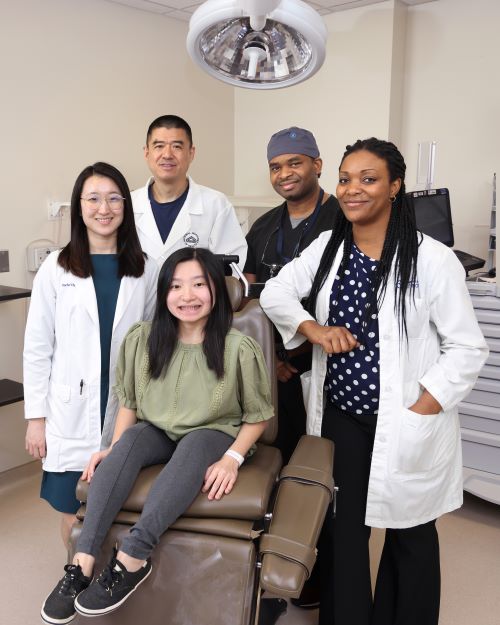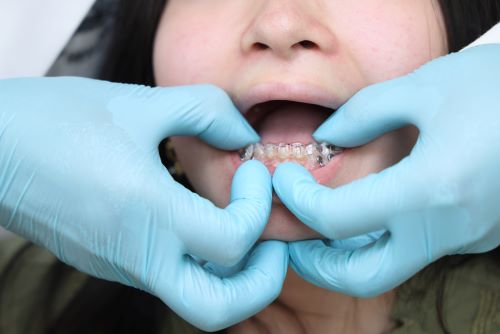Clear Plastic Aligners Give Patients with Brittle Teeth New Smiles
Multicenter clinical trial aims to improve oral health for those with a rare disorder
While 18-year-old MinFen Lydia Foreman loves food — everything from dumplings and pho to fried chicken — she has to be extra careful with each bite.
“Sometimes little pieces of teeth can break off,” said Foreman. “I can’t really eat hard foods.” Snacks like nuts, hard candies, and bowls of popcorn with half-popped kernels are off her menu.
Foreman was born with osteogenesis imperfecta (OI), a rare genetic disorder commonly known as brittle bone disease. It affects less than 20,000 people worldwide. Because OI disrupts collagen production, which is crucial for building strong bones and teeth, Foreman is smaller than most teenagers, and her bones break easily. The condition not only undermines bone strength, but it can alter skull development and cause dentinogenesis imperfecta, a disorder marked by fragile and discolored teeth.
“Because of OI, these patients have an unusual teeth misalignment called posterior open bite, which means that their back teeth aren’t touching, while their front teeth are,” said NIDCR Clinical Director and oral maxillofacial surgeon Janice Lee, D.D.S., M.D. “As you can imagine, this really limits their chewing capacity, and they may be swallowing food whole. It really is a quality-of-life issue for these individuals.”
For the past year, Foreman has been part of a multicenter clinical trial that is testing the effectiveness of FDA-approved clear plastic aligners to improve dental function in patients with OI. The trial is a collaboration with the Brittle Bone Disorder Consortium (BBDC), which is led by Brendan Lee, M.D., Ph.D., of Baylor College of Medicine. The trial is taking place at the NIH Clinical Center, the University of California, Los Angeles, and McGill University, Canada. Dr. Janice Lee leads the trial at the NIH site. Funded by the National Institute of Arthritis and Musculoskeletal and Skin Diseases, National Center of Advancing Translational Sciences (NCATS), Eunice Kennedy Shriver National Institute of Child Health and Human Development, and NIDCR, the BBDC is part of the Rare Diseases Clinical Research Network led by NCATS.
Orthodontists usually treat misalignment of healthy teeth with braces and sometimes surgery in more severe cases. However, neither treatment is optimal for patients with OI, whose misalignments are complex and teeth are fragile.
“I had a patient with OI who chipped her upper front tooth eating a burrito,” said Ling Ye, D.D.S., Ph.D., a U.S. Public Health Service Commissioned Corps Officer and orthodontist volunteer at the NIH trial site. “Their teeth may appear normal, but they have weak structure, and conventional braces may not be a good option. The brackets are bonded to the teeth, and removing them with dental instruments might break the teeth.”
Surgeries to realign teeth by cutting the jawbones are also not an option. That’s in part because clinicians and researchers are unsure how the facial bones heal in patients with OI. More importantly, these patients are often on medication that can cause bone death in the jaw when coupled with surgery — a risk that surgeons are wary of.
“It was clear that there’s an enormous unmet need in the patient community, and there have been no clinical trials tackling this problem,” said Dr. Brendan Lee, who is a pediatrician and geneticist. “Seeing how clear aligners are now in widespread use and relatively safe, our team wanted to test whether they could be a potential solution.”
In the ongoing clinical trial, on which 28 participants are currently enrolled, clinicians take 3D oral scans to customize the aligners to patients’ teeth and develop a two-year treatment plan. Instead of applying force to metal brackets anchored to fragile teeth, as is the case for conventional braces, the clear aligners gently and evenly distribute pressure across the teeth to gradually reposition them. Patients usually wear a set of aligners for a week or two before moving on to the next set.
To evaluate dental function, the researchers follow up with patients in the clinic every two months. They assess treatment progress by comparing 3D oral scans over time and measuring chewing ability with a color-changing gum, which shifts from green to pink. The better a person chews, the pinker the gum becomes.
So far, the trial’s clear aligners have shown promise as a less invasive treatment for patients with OI. Patients have responded to the treatment well and have experienced few side effects. Foreman’s 3D scans show that the clear aligner is moving her teeth and improving her posterior open bite and underbite. According to the gum test, her chewing ability has also increased.
“I have already noticed how different she feels about herself, her smile, and her teeth,” said Dee Foreman, MinFen’s mother. “It’s about chewing, eating, and swallowing, but the changes in her face have also given her confidence in such a positive way.”
Dr. Lee noted that the therapy’s aim is not one hundred percent perfection, but that it’s intended to offer an alternative to major surgeries that can be risky for patients. The team hopes the results can help guide orthodontic treatment for patients with OI and allow dental practitioners to feel confident in offering the therapy one day to patients. Beyond benefiting the OI community, the trial’s results could further establish the safety of clear aligners and inform standards of care for the general population.
“Before the clear aligners, chewing meat was tough. I had to chew for a long time, and it would get stuck in my teeth,” said Foreman. “Now, I can chew more easily, and I’m excited to see my bite fixed and have a pretty smile.”
The clinical trial is actively recruiting participants with OI aged between 12 to 40. Visit the trial website for details on the study and how to join.
Related Links
- Investigational Drug Restores Parathyroid Function in Rare Disease
- Therapy for Rare Bone Disorder Shows Promise in NIH Clinical Trial
Reference
Najirad M, Madathil SA, Rauch F, Sutton VR, Lee B, Retrouvey JM, et al. Malocclusion traits and oral health-related quality of life in children with osteogenesis imperfecta: A cross-sectional study. J Am Dent Assoc. 2020 Jul;151(7):480-490.e2. doi: 10.1016/j.adaj.2020.03.040.
NIH Support: In addition to NIDCR, support for this research came from the National Institute of Arthritis and Musculoskeletal and Skin Diseases, National Center of Advancing Translational Sciences, and Eunice Kennedy Shriver National Institute of Child Health and Human Development.
Attention Editors
Reprint this article in your own publication or post to your website. NIDCR News articles are not copyrighted. Please acknowledge NIH's National Institute of Dental and Craniofacial Research as the source.
Subscribe for NIDCR Updates
Receive email updates about the latest advances in dental, oral, and craniofacial research.
October 2024




